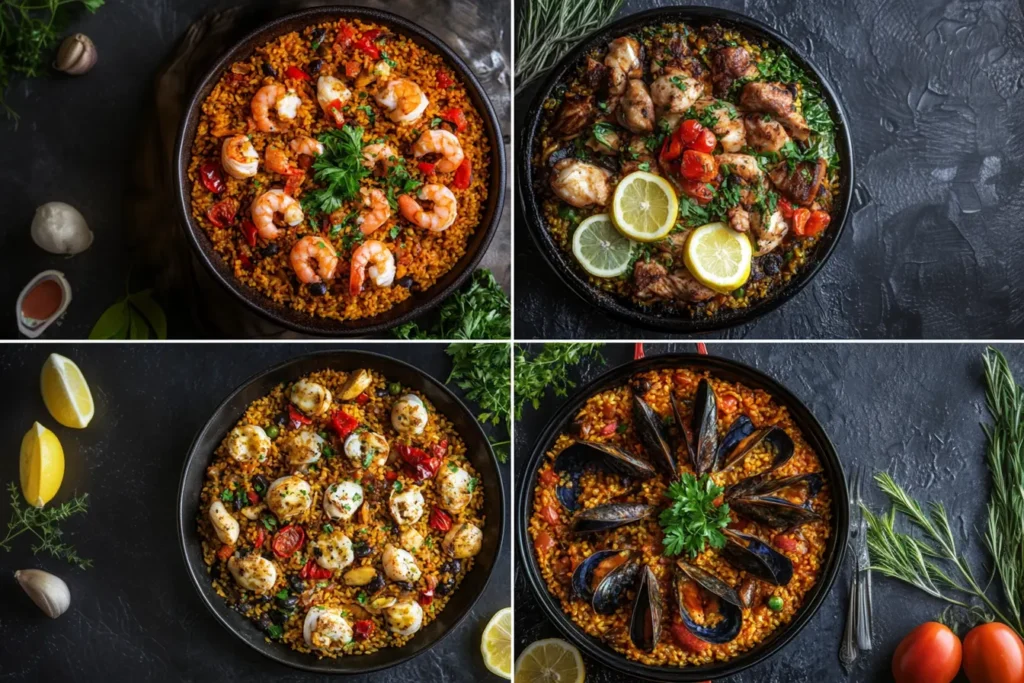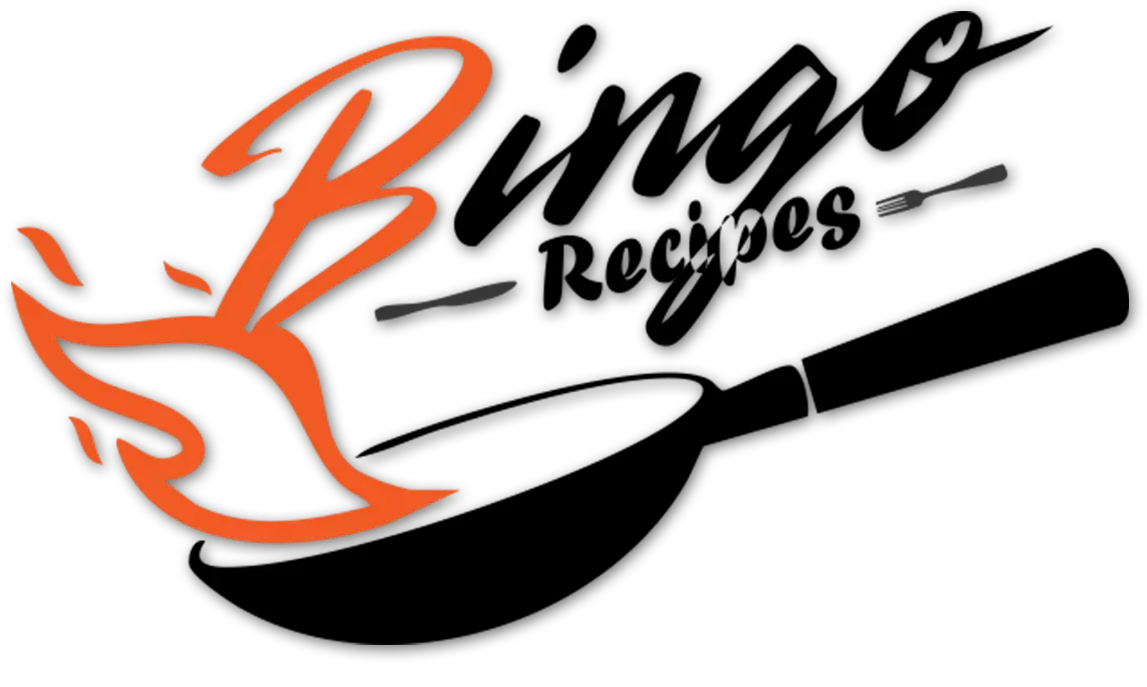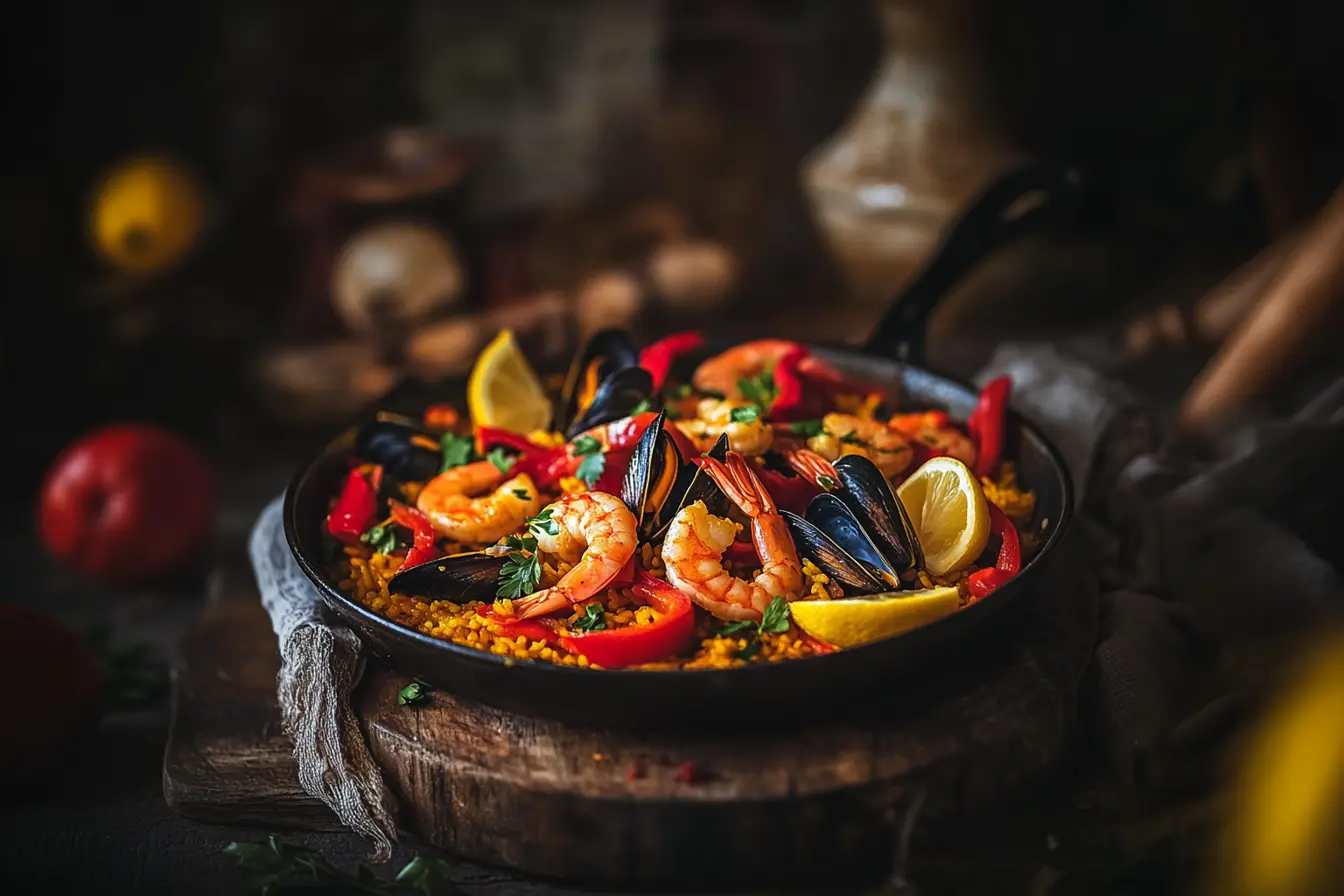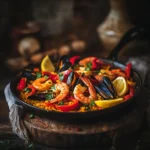Paella, a world-famous Spanish rice dish, is a vibrant and flavorful meal that embodies the essence of Spanish cuisine. Originating from the sunny region of Valencia, Spain, this saffron-infused dish has captured the hearts of food lovers across the globe. Whether you’re savoring a seafood-packed version or indulging in the traditional Paella Valenciana, each bite tells a story of rich culinary history and passion for bold flavors.
In this comprehensive guide, we’ll explore everything you need to know about paella—its origins, ingredients, different variations, and how to make an authentic paella at home. By the end of this article, you’ll not only appreciate the cultural significance of Spanish dish paella but also be inspired to cook your own version.
History of Paella (DoFollow External Link): Official Visit Valencia Guide – The Origins of Paella
What is Paella?

Paella is more than just a dish—it’s an experience! This iconic Spanish cuisine is known for its golden, aromatic rice, perfectly cooked in a wide, shallow pan, and infused with a medley of bold ingredients. But what makes paella so special? Let’s break it down.
The Origin of Paella
The Spanish dish paella traces its roots back to the rice fields of Valencia, where farmers cooked rice with whatever ingredients they had on hand—rabbit, chicken, and local beans. Over time, this rustic meal evolved into a globally recognized Spanish rice dish, enjoyed by millions.
Interestingly, the word paella refers not just to the dish but also to the wide, shallow pan in which it’s cooked. Traditionally, paella was prepared outdoors over an open flame, creating the beloved crispy layer of rice at the bottom, known as the socarrat.
Why Paella is a Symbol of Spanish Cuisine
In Spain, paella is more than food—it’s tradition. Families gather around a massive pan of steaming paella during celebrations, Sunday lunches, and festivals. It represents community, hospitality, and the love of authentic Spanish flavors.
Today, paella is a staple in Spanish restaurants worldwide. While the classic Paella Valenciana remains the most authentic version, there are endless variations to explore.
Different Types of Paella
Paella comes in many delicious varieties, with ingredients ranging from seafood to vegetables and even mixed meats. The three most popular types include:
- Paella Valenciana – The original recipe, featuring rabbit, chicken, green beans, and snails.
- Seafood Paella – A coastal favorite, packed with shrimp, mussels, squid, and lobster, infused with saffron.
- Vegetarian Paella – A plant-based delight made with bell peppers, artichokes, mushrooms, and aromatic spices.
Each version maintains the core elements of paella—short-grain Bomba or Calasparra rice, saffron, and a deep, rich broth.
History and Cultural Significance of Paella
Paella is more than just a delicious dish—it’s a symbol of Spanish culture and heritage. This Spanish dish paella has a fascinating history that dates back centuries and represents the diversity of Spain’s culinary traditions.
The Birthplace of Paella – Valencia
The origins of paella can be traced to Valencia, a coastal city in eastern Spain. In the 10th century, when the Moors introduced rice to Spain, Valencians began cultivating it in their wetlands. Over time, rice became a staple, and local farmers developed a one-pan dish using short-grain rice, saffron, and fresh ingredients from the land.
Originally, Paella Valenciana included rabbit, chicken, green beans, and snails. However, as the dish spread to other regions, different versions emerged, using seafood, chorizo, and even vegetarian ingredients.
Traditional vs. Modern Interpretations
Traditionally, paella was cooked over an open flame using orange wood, which gave the dish its distinct smoky flavor. The goal? Achieving the perfect socarrat—the crispy, caramelized rice layer at the bottom of the pan.
Today, paella is a global dish, with chefs experimenting with new flavors and ingredients. While some purists argue that only the Valencian recipe is authentic, modern variations have gained widespread popularity, especially seafood paella and mixed paella.
How Paella Represents Spanish Culinary Diversity
Paella is deeply woven into Spain’s culinary identity. It’s served at festivals, family gatherings, and Sunday lunches, bringing people together over a giant steaming pan of rice.
From its humble Valencian roots to its modern-day popularity, Spanish dish paella remains a timeless classic, celebrated for its bold flavors and communal spirit.
Key Ingredients for the Perfect Paella
To make an authentic paella, choosing the right ingredients is key. From the perfect rice to the aromatic saffron, every component plays a crucial role in achieving that signature taste.
Essential Ingredients: Rice, Saffron, and Broth
- Rice – The heart of any Spanish dish paella is the rice. Short-grain varieties like Bomba or Calasparra absorb liquid without becoming mushy. These rice types expand up to three times their size, creating the perfect fluffy yet firm texture.
- Saffron – Known as oro rojo (red gold), saffron gives paella its signature golden hue and delicate floral aroma. Always use pure saffron strands, as artificial substitutes lack depth of flavor.
- Broth (or Stock) – A rich, homemade broth enhances the overall taste. Seafood broth works best for Seafood Paella, while chicken or vegetable broth suits other varieties.
The Role of Seafood, Meat, and Vegetables
Depending on the type of paella, you can mix and match meats, seafood, and veggies:
- Paella Valenciana: Rabbit, chicken, snails, and green beans for the most traditional version.
- Seafood Paella: Shrimp, mussels, calamari, and lobster bring out the ocean’s essence.
- Vegetarian Paella: Bell peppers, artichokes, mushrooms, and asparagus make for a hearty plant-based alternative.
Other essential ingredients include smoked paprika, garlic, tomatoes, and olive oil, which all contribute to the rich, savory base.
Paella Pan and Cooking Equipment
A true paella experience isn’t complete without the right equipment:
- Paella Pan (Paellera) – A wide, shallow pan allows for even cooking and helps create the perfect socarrat.
- Heat Source – Traditional wood-fired cooking is preferred, but a gas burner or stovetop works just as well.
- Wooden Spoon – Stirring with a wooden spoon prevents breaking the grains and maintains the paella’s texture.
With these key ingredients and tools, you’re ready to create a restaurant-quality paella at home. Up next, we’ll guide you through a step-by-step process for cooking Spanish dish paella to perfection! 🍽️🔥
How to Make an Authentic Spanish Paella

Nothing beats the taste of homemade Spanish dish paella, packed with bold flavors, aromatic spices, and the perfect texture. Follow this step-by-step guide to create an authentic paella that captures the essence of Spain.
Step-by-Step Cooking Instructions
1. Prepare the ingredients
Gather all your essentials: Bomba rice, saffron, broth, protein (chicken, seafood, or veggies), tomatoes, olive oil, and spices. Chop vegetables and clean seafood beforehand.
2. Heat the paella pan
Set your paella pan over medium-high heat. Add a generous drizzle of olive oil and let it heat before adding proteins.
3. Sear the proteins
If making Paella Valenciana, start by browning the chicken and rabbit. For seafood paella, sear the shrimp and squid for a minute, then remove them.
4. Build the flavor base (sofrito)
Add garlic, onions, grated tomatoes, and smoked paprika to the pan. Let them cook down into a thick, aromatic mixture.
5. Toast the rice
Sprinkle the Bomba rice evenly across the pan. Stir it with the sofrito for 1-2 minutes to absorb the flavors.
6. Add saffron-infused broth
Dissolve saffron strands in warm broth and pour it gently into the pan. Do not stir—paella relies on even rice distribution.
7. Arrange the ingredients
Place the proteins and vegetables evenly across the pan. If using mussels or clams, nestle them into the rice.
8. Simmer and cook
Let the paella simmer for 15-20 minutes until the rice absorbs the liquid. Avoid stirring—it helps form the prized socarrat (crispy bottom).
9. Let it rest and serve
Once cooked, remove from heat, cover with foil, and let it rest for 5 minutes. Serve with fresh lemon wedges for a burst of acidity.
Common Mistakes to Avoid
- Using the wrong rice – Stick to Bomba or Calasparra rice. Other types won’t absorb liquid properly.
- Over-stirring the rice – Unlike risotto, paella should not be stirred while cooking.
- Skipping the socarrat – The crispy, caramelized rice layer at the bottom adds texture and flavor.
Pro Tips from Spanish Chefs
- Cook over an open flame for a smoky, authentic taste.
- Use fresh seafood for the best seafood paella experience.
- Experiment with spices, but never skip saffron—it’s the heart of paella.
Now that you’ve mastered the cooking process, let’s explore the most delicious paella variations to try at home!
Best Variations of Paella to Try

While Paella Valenciana remains the most traditional, this Spanish dish paella has evolved into countless variations. Here are the most popular types you should try!
Paella Valenciana – The Traditional Recipe
This is the original paella, made with chicken, rabbit, green beans, and saffron-infused rice. It’s rich, savory, and perfect for those who want a classic taste of Spain.
Best for: Traditionalists who love a hearty, meat-based dish.
Seafood Paella – The Most Popular Version
This version swaps meat for mussels, shrimp, squid, and clams, creating a dish bursting with ocean flavors. The seafood’s natural brininess enhances the rice’s depth and complexity.
Best for: Seafood lovers who crave a fresh, vibrant dish.
Mixed Paella – A Perfect Combination
For those who want the best of both worlds, mixed paella includes chicken, seafood, and vegetables, making it a versatile and crowd-pleasing option.
Best for: People who can’t decide between meat or seafood.
Vegetarian and Vegan Paella Options
Who says paella has to include meat? A delicious vegetarian version can be made with artichokes, bell peppers, mushrooms, and asparagus. Swap chicken broth for vegetable broth to keep it plant-based.
Best for: Vegetarians and those looking for a lighter dish.
Black Paella (Arroz Negro) – A Unique Twist
This dramatic black-colored paella gets its color from squid ink, giving it an intense umami flavor. It’s a favorite among seafood lovers.
Best for: Adventurous eaters looking for something bold and different.
No matter which paella variation you choose, the key to a great paella lies in fresh ingredients, proper technique, and a bit of patience. Ready to discover where to find the best paella in Spain? Keep reading! 😊
Where to Eat the Best Paella in Spain
While making Spanish dish paella at home is a rewarding experience, tasting an authentic paella in Spain is an unforgettable culinary journey. From bustling markets to seaside restaurants, here’s where you can find the best paella in the country.
Top Paella Restaurants in Valencia
Since Valencia is the birthplace of paella, it’s the best place to experience the dish in its most traditional form. Some must-visit spots include:
- Restaurante La Pepica – A legendary seafood restaurant loved by celebrities, serving some of the best seafood paella in Valencia.
- Casa Carmela – Known for its wood-fired Paella Valenciana, prepared using time-honored techniques.
- El Racó de la Paella – A hidden gem where locals enjoy homemade-style paella.
Madrid, Barcelona, and Beyond – Where to Find the Best Paella
If you’re outside Valencia, don’t worry—Spain has plenty of top-notch paella spots.
- Barcelona: Can Majó – A seafood lover’s paradise with fresh-caught ingredients in every bite.
- Madrid: Casa de Valencia – A restaurant dedicated to authentic Valencian paella, right in the capital.
- Seville: La Paella Sevilla – Serves flavor-packed traditional paellas in the heart of Andalusia.
What to Look for in an Authentic Paella Restaurant
Want to avoid tourist traps? Here’s what to check before ordering paella in Spain:
✔ Cooked to order – Authentic paella takes at least 30-45 minutes to prepare. If it’s ready in 10 minutes, it’s not fresh!
✔ Served in a paella pan – Paella should always be brought to the table in its original cooking pan.
✔ No chorizo in sight – Traditional Spanish dish paella doesn’t include chorizo—beware of places catering to tourist preferences.
Next time you’re in Spain, don’t miss the chance to enjoy a truly authentic paella experience!
Frequently Asked Questions
Paella is a beloved dish, but it also comes with many questions. Let’s answer some of the most common ones!
Is paella originally from Spain?
Yes! Paella originated in Valencia, Spain, during the Moorish era, when rice became a staple ingredient. Over time, it evolved into the dish we know today, rich in saffron, proteins, and vegetables.
What is the difference between paella and risotto?
Both dishes feature short-grain rice, but their cooking methods and textures differ:
Paella is cooked in a wide, shallow pan, absorbing broth without stirring, creating a crispy socarrat at the bottom.
Risotto is constantly stirred, developing a creamy consistency due to the slow release of starch.
Can you make paella without saffron?
Technically, yes—but it won’t taste the same. Saffron is what gives Spanish dish paella its distinct golden color and floral aroma. If unavailable, turmeric can be a substitute, though it lacks saffron’s complex depth of flavor.
What is the best rice for making paella?
The best rice varieties for paella are:
Bomba rice – The most traditional, known for absorbing flavors without getting mushy.
Calasparra rice – Slightly longer cooking time but absorbs more liquid, enhancing the dish’s richness.
Avoid using long-grain or basmati rice, as they don’t absorb liquid properly, resulting in an inauthentic texture.
That concludes this comprehensive guide to Spanish dish paella! Whether you’re making it at home or traveling to Spain for the real deal, this dish will always bring people together over a flavorful, comforting meal.
Would you like to add a wine pairing guide to enhance the dining experience? 🍷😊
Best Wine Pairings for Spanish Dish Paella
Pairing the right wine with paella enhances the flavors and creates a more enjoyable dining experience. Since Spanish dish paella comes in various styles—seafood, meat, vegetarian—choosing the perfect wine depends on the ingredients.
Best Wines for Seafood Paella
Seafood paella, with its briny, delicate flavors, pairs well with crisp, refreshing white wines that don’t overpower the dish. Try these options:
- Albariño – A classic Spanish white wine with citrusy, mineral notes that complement shrimp, mussels, and squid.
- Verdejo – Offers a slightly herbal, green apple flavor that balances the saffron and seafood combination.
- Cava (Spanish Sparkling Wine) – The light bubbles cleanse the palate, making every bite taste fresh.
Best Wines for Paella Valenciana
Since Paella Valenciana includes chicken, rabbit, and beans, it pairs well with medium-bodied white or light red wines. Some great choices include:
- Viura (White Rioja) – Has a subtle oakiness that enhances the savory flavors of traditional paella.
- Garnacha (Grenache) – A fruit-forward, low-tannin red that won’t overpower the dish.
Best Wines for Mixed or Meat Paella
For mixed or chorizo-infused paellas, go for bold, structured wines that stand up to the dish’s richness:
- Tempranillo – Spain’s famous red wine, packed with red fruit and earthy flavors that complement smoky chorizo.
- Monastrell (Mourvèdre) – A fuller-bodied option with hints of spice that match the complexity of mixed paella.
Tips for Hosting a Perfect Paella Night
There’s nothing better than sharing a big pan of Spanish dish paella with friends and family. Hosting a paella night is a fun way to bring people together over delicious food, great conversation, and a relaxed atmosphere.
Plan Ahead for a Stress-Free Experience
Paella is best enjoyed fresh, so a little preparation goes a long way:
✔ Choose your paella type – Decide between Paella Valenciana, seafood paella, or a mixed version based on your guests’ preferences.
✔ Gather fresh ingredients – Buy high-quality saffron, short-grain rice, and proteins ahead of time to avoid last-minute stress.
✔ Prepare the sofrito early – The garlic, tomatoes, onions, and paprika base can be made in advance to save time.
Set Up an Outdoor Cooking Space
Cooking Spanish dish paella outdoors adds to the authentic experience and lets guests enjoy the process. If possible:
🔥 Use a traditional paella burner – This ensures even cooking and allows for a perfect crispy socarrat.
🔥 Cook over an open flame – If you have a grill, it’s a great way to infuse that subtle smokiness into your paella.
Pair Paella with the Right Side Dishes
A well-rounded paella night includes more than just the main dish. Complement your meal with:
- Pan con tomate – Toasted bread with fresh tomato, garlic, and olive oil.
- Spanish olives & almonds – Great for snacking before the paella is ready.
- Sangria or Cava – A refreshing drink to balance the flavors of the meal.
Make it a Social Event
The beauty of paella is that it’s meant to be shared. Involve your guests in the process:
- Let someone stir the sofrito while chatting.
- Have another guest pour the broth and saffron mixture.
- Make it interactive and fun—everyone will feel part of the meal!
By the time the paella is ready, you’ll have created not just an amazing dish, but lasting memories. 🎉
PrintSpanish Dish Paella: A Delicious & Authentic Recipe
Discover the secrets of Spanish dish paella! Learn how to make authentic paella with the best ingredients, cooking tips, and regional variations.
- Prep Time: 20 minutes
- Cook Time: 40 minutes
- Total Time: 1 hour
- Yield: 4–6 people 1x
- Category: Lunch
- Method: NA
- Cuisine: Spanish
Ingredients
- 2 cups Bomba or Calasparra rice
- 4 cups chicken or seafood broth
- 1/2 teaspoon saffron threads
- 2 tablespoons extra virgin olive oil
- 1 onion, finely chopped
- 2 cloves garlic, minced
- 1 teaspoon smoked paprika
- 1/2 cup tomato puree
- 1 red bell pepper, sliced
- 1/2 cup green beans
- 1/2 lb chicken thighs, chopped
- 1/2 lb shrimp, cleaned and deveined
- 1/2 lb mussels, scrubbed and de-bearded
- Lemon wedges for serving
- Salt and pepper to taste
Instructions
- Prepare the Ingredients: Soak saffron threads in warm broth for 5 minutes. Chop vegetables and prepare seafood/meat.
- Heat the Pan: Add olive oil to a wide paella pan, heat over medium, and sauté onions, garlic, and smoked paprika.
- Cook the Proteins: Brown the chicken, then remove. Sear shrimp and mussels briefly, then set aside.
- Prepare the Base: Stir in tomato puree, red bell peppers, and green beans. Let it cook until softened.
- Toast the Rice: Add Bomba rice, stirring to coat in the flavors.
- Add the Saffron Broth: Pour in saffron-infused broth and spread rice evenly—do not stir.
- Simmer Until Done: Let the rice cook for 15-20 minutes. Return the shrimp, mussels, and chicken to the pan.
- Achieve Socarrat: Increase heat for the final 2 minutes to create the crispy rice layer at the bottom.
- Rest & Serve: Remove from heat, let it rest for 5 minutes, then serve with fresh lemon wedges.
Notes
NA
Nutrition
- Serving Size: 4-6 people
- Calories: 480 kcal
- Sugar: 5g
- Sodium: 700mg
- Fat: 12
- Saturated Fat: 3g
- Unsaturated Fat: NA
- Trans Fat: NA
- Carbohydrates: 60g
- Fiber: 4G
- Protein: 32G
- Cholesterol: 110mg
Keywords: paella, Spanish cuisine, Spanish rice dish, seafood paella, traditional paella, easy paella recipe


